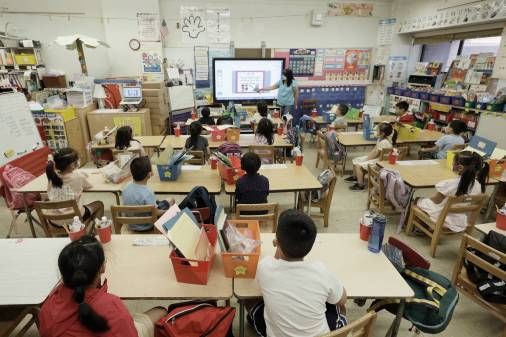Connecticut report calls for mastery-based learning in K-12 schools

A recent report assessing Connecticut’s position as an educational innovator found that the state would benefit most by adopting a student-centered learning model and provided a series of recommendations on how to transform its education system.
The report, “Charting New Frontiers in Student-Centered Learning,” was issued by the Connecticut Association of Public School Superintendents (CAPSS), the Connecticut Commission for Educational Technology (CET) and Innovation Partners America, an education consultancy.
“This report started out as a really simple question,” Doug Casey, executive director of CET, told EdScoop. “If it’s possible to improve education using approaches that depend on and scale technology, why aren’t districts doing this more systematically? Why aren’t we seeing the adoption of promising practices?”
The authors of the report approached more than 20 educational leaders in the state from a diverse range of organizations, including schools, agencies and advocacy groups. The leaders were surveyed on 10 education-related topics and provided feedback on their organizations and the state of student-centered learning in Connecticut.
According to Casey, the survey revealed two primary differences in how leaders view student-centered learning. Although everyone was in agreement about its importance, there was a divide between those who believe that the current educational system could be improved to support innovation and those who believe that an entirely new system must be created.
This discrepancy led the report’s authors to explore the characteristics and effects of two paradigms of learning for their state: a school-centric paradigm and a student-centric paradigm.
“In a school-centric paradigm — where all components of the system are designed for efficiency of education delivery and in the context of standardized schools — the current school-centered system is often referred to as ‘factory-like,’” the report stated.
In this paradigm, a standard curriculum determines what every student is expected to know and be capable of by the end of each year in school. Then, when students don’t meet these expectations, the system flags this issue but continues to serve the student through the same methods — the methods that didn’t work the first time around.
“For most,” the report noted, “this approach and this system fail them.”
In a student-centric paradigm, however, schools recognize students’ uniqueness and design a learning process that is flexible and tailored to each student’s individual needs.
“Student-centered learning accepts the reality that not every child is going to look the same coming out of the system. It embraces that reality. Student-centered systems must be intentionally created; they are not the result of reform and innovation,” the report stated.
Casey likened the concept of student-centered learning to an apprenticeship model, then described an example involving Paul Revere.
Revere was a silversmith, said Casey. So, if he was teaching an apprentice, Revere wouldn’t tell his student, ‘OK, we’ll be studying the forge module this week. At the end of the week, I’ll test you, and if you provide something of D-level quality, you’ll pass and we’ll move on to the next subject.’
“That sounds kind of ridiculous,” said Casey. “He would sit there with his apprentice, watch this person learn and tailor the learning to the person. When the student mastered the technique, then it was time to move on.”
According to the report, mastery-based learning won’t just improve the education students receive. It will also solve equity issues in the education system.
“Connecticut ranks nationally as one of the states with the highest student performance, yet the data mask discrepancies in test scores that continue between different socioeconomic, racial and cultural groups,” the report states. “Central to the challenge of equity, however, is determining if we imagine the solution to hinge on closing gaps on test scores versus allowing learners different ways to demonstrate their learning and mastery.”
Based on surveyed feedback and the research they conducted, the authors of the report provided a set of five recommendations for Connecticut’s education system.
They first recommend that leaders in education develop a common vision of student mastery by the conclusion of high school and then use this new vision to drive and inspire the development of an intentional framework, setting principles that direct policy — both statewide and locally — to recognize different learners and how they can be supported in their pathways to success.
They also recommend the creation of joint “innovation labs,” which would “act as a catalyst for a broader research and development movement.”
Finally, according to the report’s authors, Connecticut’s education leaders should enact a campaign to identify and amplify the work of student-centered pioneers and identify untapped resources.
Ultimately, the report asserts a need for substantial shifts in policy and practices to drive the future of student-centered learning.
Although the research presented in “Charting New Frontiers in Student-Centered Learning” focuses on the specific needs of Connecticut’s education system, these are topics that apply across the nation, said Casey.
“I would strongly argue that, if someone replicated the kind of study that we’re doing, the specific answers would definitely vary,” Casey noted. “I’m sure you would see state-by-state differences, but there are some universal truths that any state would find.”




